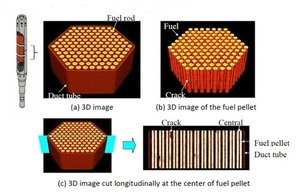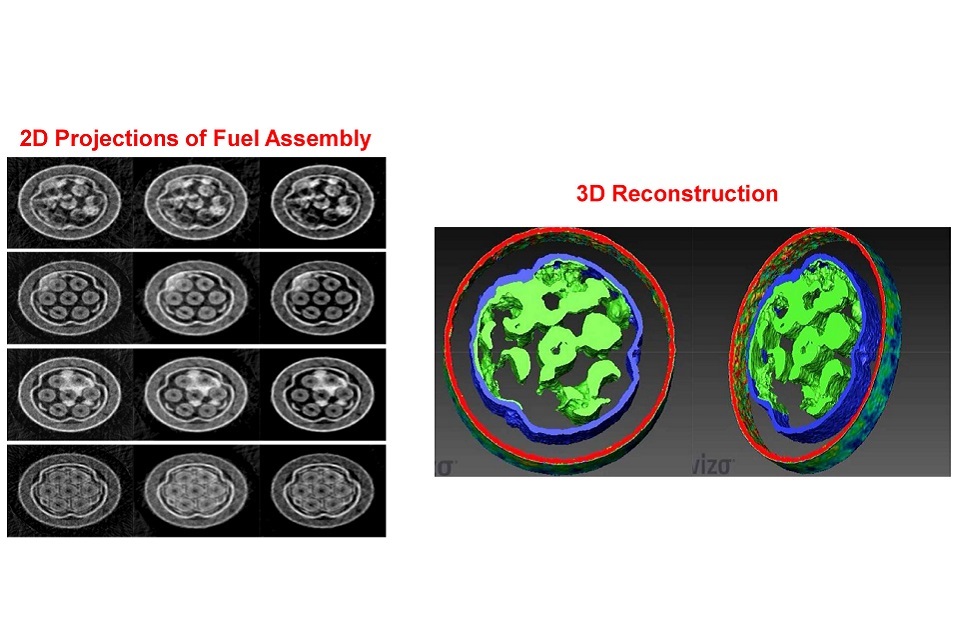Role of 3D imaging in managing spent fuel stored under water
A range of 3D imaging techniques are being investigated to assess their value in predicting how spent AGR fuel is likely to behave over time when stored under water.

X-ray computed tomography of fuel assemblies (a) 3D Image of the fuel rod and duct tube (b) 3D image of the fuel pellet (c) 3D image cut longitudinally at the centre of the fuel pellet.
Challenge:
Predict the long-term behaviour of spent AGR fuel during storage in Sellafield ponds
Solution:
Investigate effectiveness of 3D imaging techniques to provide accurate understanding of fuel and cladding
| Benefits | Greater certainty in addressing challenges around long-term wet AGR fuel storage, together with potential to use 3D imaging techniques for other fuels and structures across the group; reduced cost in (unnecessary mitigation) |
| Status | Initial studies complete, providing detailed overview and recommendations |
| R&D driver | Informing strategy |
| Research organization | Wood plc |
The NDA is contractually committed to receive and manage all of the spent fuel from the 7 EDF Energy (EDFE) Advanced Gas Cooled Reactor (AGR) power stations in England and Scotland. In 2018, the NDA finished reprocessing the contracted amount of spent AGR fuel at Sellafield’s Thermal Oxide Reprocessing Plant (THORP). After THORP’s closure, our plan for the remaining AGR and other spent oxide fuels is interim storage, pending a future decision on whether to declare them as waste for disposal in a GDF. The current plan is that GDF will be available to receive high-heat generating waste in 2075.
To understand how the stored wet fuel is likely to behave over time, the NDA is exploring a range of 3D imaging techniques that can, for example, scan through the cladding and inside the materials to characterise changes such as cracking, voids, corrosion or cladding stress/failure. Building an accurate picture of possible developments will enable risks to be predicted over the long term and remedial action to be taken where necessary.
Although the research commissioned is specific to AGR fuel stored at Sellafield, successful technologies would bring wider benefits across the group, in characterising other nuclear materials or structures, and understanding long-term developments of packaged materials.
Studies focused on non-destructive 3D imaging, analysing a wide range of technologies, based on methods already in use either in nuclear or other industries and countries, as well as those at much earlier stages of experimentation. Some technologies were still being developed by research organisations, both in the UK and overseas.

Irradiated fuel assemblies, as depicted by neutron tomography techniques
Methods considered included X-ray, neutron, gamma, ultrasound, muon and atom probe technologies. The capabilities of differing techniques were assessed, to understand how they might support R&D work on spent AGR fuels, whether they were readily available in the UK and suitability for a nuclear environment. With some techniques, it is possible to virtually “walk” inside the material, find interesting sections of the image and inspect it more closely by zooming in.
All offered benefits and disadvantages, with the main drawbacks including the complexity and effort required for data capture and image processing.
However, the study concluded that 3D imaging could potentially help in improving understanding in several AGR related R&D topics such as corrosion rates and mechanisms of AGR cladding and understanding of pond containment. A further recommendation was to consider combining a number of technologies to provide an even more comprehensive approach. This could potentially provide greater scientific insight than if individual techniques were used in isolation.
Further reading
This case study is part of the Direct Research Portfolio Report 2018 to 2019
Also available is the previous DRP Report 2017 to 2018